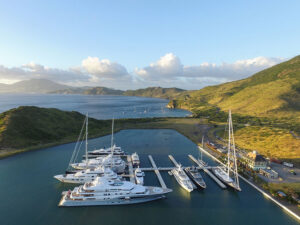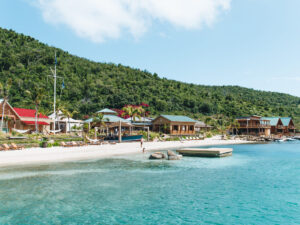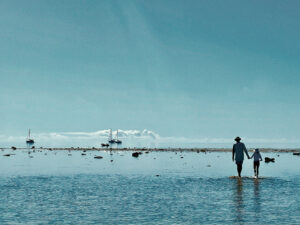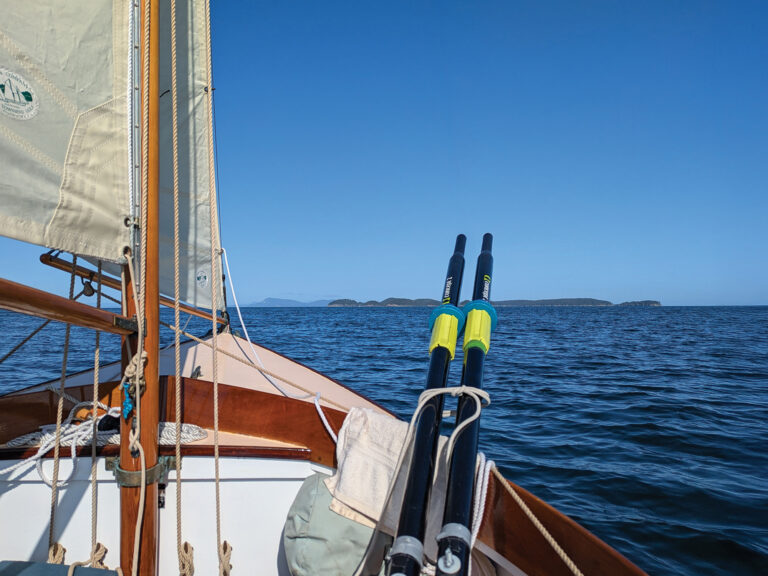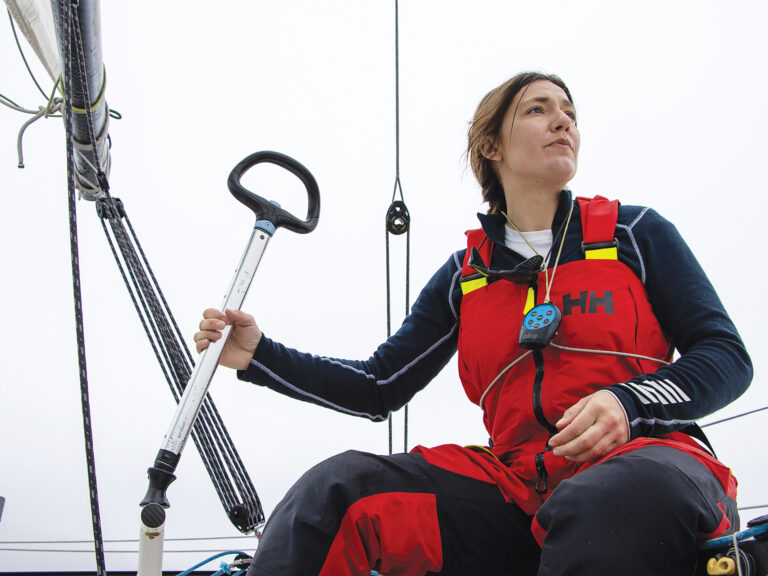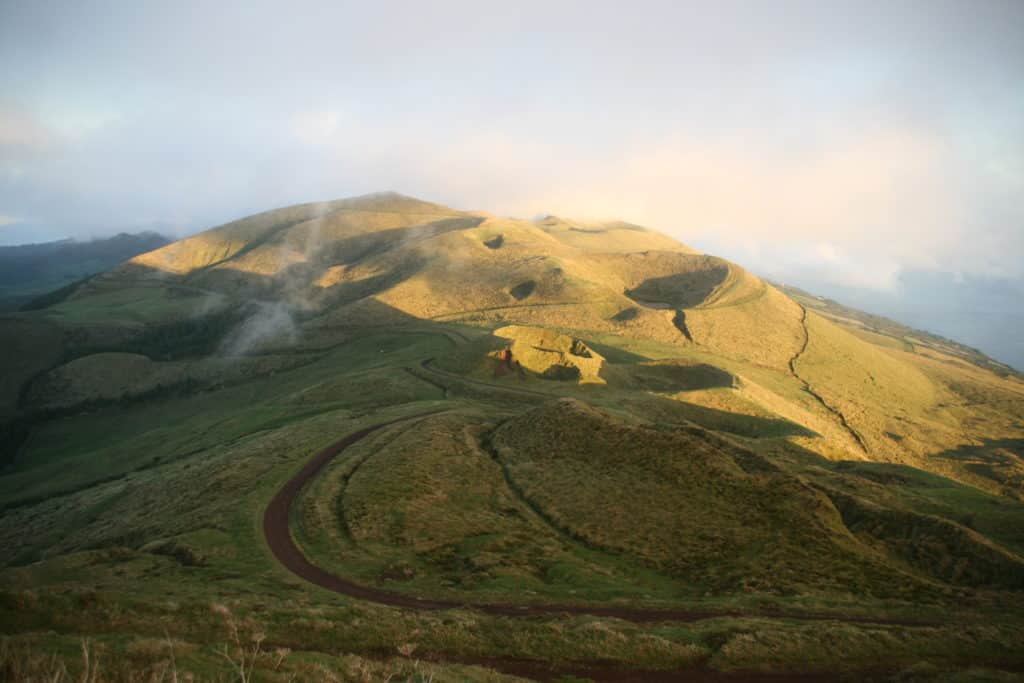
With a fresh southerly coursing across the waters, and making better than 7 knots on a powerful beam reach, we pointed Primo’s bow toward Velas Marina on São Jorge Island, covering the 22 miles from Horta in about four hours after briefly losing the breeze in the lee of Pico Alta, the 7,700-foot volcanic peak on the island of Pico that’s the dominant, ever-looming feature of the central group. “We’re out in the middle of the Atlantic Ocean!” marveled Ian, an obvious statement that was still hard to grasp, especially given the benign conditions. It was a sunny, sensational day for sailing, but strangely, after a brief glimpse of another yacht as we left Horta, there wasn’t a single boat to be seen. It felt like we had this miraculous waterborne amphitheater, bordered by islands in every direction, all to ourselves.
Velas Marina was a minor miracle, a compact hidy-hole behind a formidable breakwater with berths for about 80 yachts, but only a handful are reserved for transients. It seemed to have been carved directly out of a 200-foot cliff, the tall perimeter of which was lined with the nests of Cory’s shearwaters, which enjoyed the ultimate bird’s-eye view.
As with every harbor in the Azores, you need to clear in and clear out, which is how we met port captain Filipe Silveira, who spoke excellent English and couldn’t have been a better ambassador for his island. When we told him we would be spending only a single night so we could sail on to Terceira the next day, he flatly told us we were making a huge mistake. “The hiking trails, the waterfalls, the swimming,” he said. “You will miss it all.”
Anyway, determined to have at least a brief look around, we strolled into the nearby village square and were astounded by the ancient parish church and town hall, the intricate gardens and the amazing paving stones. But we also wanted to get some elevation for a broader view, so we hired a cabbie called Manuel to take us for a ride. Our Portuguese, of course, was nonexistent, and Manuel spoke little English, but he did understand “up” and “more up,” and before we knew it, we were on a long tour of the island.
As we gained altitude, winding through thick stands of trees on a road lined with brilliant hydrangea, it just got better and better. Once beyond the tree line, we found ourselves in lush, terraced pastureland where cows have grazed for centuries — and are grazing still — and the shadowed cordillera of volcanoes long ago erupted. Even the aroma was great. Carole, who grew up in the dairy country south of Sydney where the movie Babe was filmed, took a deep breath and said, “It smells like home.” On top of all that, the view of Pico, cast in the low light of the setting sun, was magnificent.
The next morning, against Filipe’s advice, we took off for Terceira, some 50 miles distant, which Anabela, during our orientation, insisted we visit. The historic city of Angra do Heroismo, beautiful lakes and stunning caves, perhaps even a bullfight: Terceira was said to be one of the highlights of the Azores.
And this is where our flight snafus caught up with us. Had we arrived on time in the first place, we would’ve had the previous wonderful day to sail to Terceira. Instead, we never got there.
Not that we didn’t try. Leaving Velas, we popped outside the marina and realized, though it had been windy in the protected basin, that in the open water, the dogs were getting completely blown off their chains. Worse, it was blowing southeast at a staunch 25 knots with higher gusts, basically the direction we needed to go. There was a ripping seaway building and waves crashing against the exposed shoreline, sending plumes of spray high into the air. Unlike the previous day, there was now no doubt we were in the middle of the tempestuous Atlantic. Still, it takes a lot for me to get the hint, so we hoisted a deeply reefed main and attempted to claw upwind. After all, we needed to see Terceira! But as we crashed and rolled, with solid waves burying the foredeck, it was readily apparent we’d be in for an ordeal, and at least a 10-hour one at that. So we bailed out and returned to São Jorge. The women were visibly relieved, and secretly, so was I. “Discretion is the better part of valor,” said Ian. He was, of course, correct.
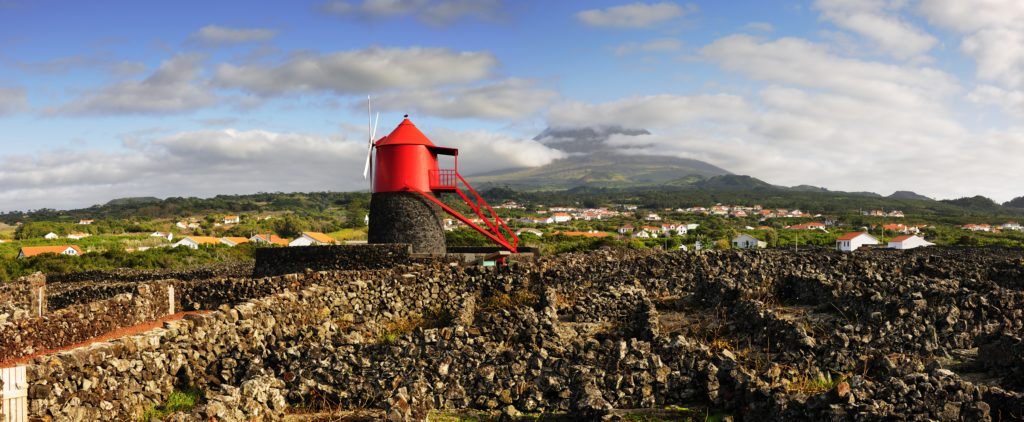
Thanks to Felipe, however, we had a Plan B: a long hike down and along the northern shore of São Jorge, which proved to be like something right out of The Hobbit.
We hailed a cab and, following Felipe’s advice, were dropped off at a trailhead about a thousand feet above the coastline near Pico do Esperanço, beginning the trek, quite literally, in the ever-present cloud that the island is known for. (The helpful cab driver promised to pick us up at a designated rendezvous spot about 6 miles down the coast a few hours later.) It doesn’t rain much on São Jorge, but the moist atmosphere keeps the flora and fauna green and flourishing. After descending a few hundred feet, we exited the thick mist and were greeted with sunshine, which provided breathtaking views of the north shore, including several of the fájas – low tongues of old lava that slid down the hills and extend into the sea – for which São Jorge is renowned. About that time, we ran into a small group of cattle munching their lunch from scrub just off the well-marked trail. It was like a hallucination; none of us had ever seen mountain-climbing cows.
Halfway along, sweaty from the exertion, we stumbled across the waterfall Felipe mentioned, and Ian and I took the plunge into the clear, cool, wonderful water. It was sensational. Continuing on, once we’d reached sea level, at the Santo Cristo fája — a ring-shaped lagoon that provides a world-class surf break — we met a bunch of Aussie surfers who’d rented a simple shoreside shack from Airbnb and were spending a couple of weeks chasing waves. I knew the surf had to be special when they said they were from Byron Bay, a famous Aussie break in its own right. They’d come an awfully long way in search of a better wave than the one in their own backyard.
At the end of the line, above and beyond our awaiting taxi, there were a couple of treats: a small chapel with a breathtaking statue of the Virgin Mary in the crypt of a volcano, and a tiny cafe serving icy Sagres beers for 1 euro apiece. It was nourishment for the body and the soul.
The next day, with our time evaporating and a run to Terceira now completely out of the question, we quickly knocked off the short trip across the channel from São Jorge to Pico, where we picked up a free mooring off the whaling museum in the town of São Roque do Pico. These days, whale-watching is the only whale-related activity in the Azores, but for centuries whaling was an important part of the local economy, and was still in practice as recently as the early 1980s before being outlawed altogether.
Once ashore, for 50 euros we hired another cabbie, 82-year-old Joe Souza (yes, there were Souzas in my high school too), for a rambling four-hour drive from one end of the 28-mile-long island to the other. Joe looked about 20 years younger than his age, spoke great English and, like every taxi driver we hired, he’d spent a good 20 years working in the United States — in his case in Fall River, Massachusetts, another New England stronghold of Azorean immigrants.
One of the highlights surely was lunch, which we enjoyed at a local restaurant overlooking the sea that served fresh fish along with chewy bread and the famous cheese and wine that Pico is known for. At subsequent stops along the coastline, we wandered through lava arches and formations that have been formed over the centuries, and many picturesque saltwater swimming pools built directly into the rocky landscape, which provide the islanders and visitors places to swim and sunbathe in the absence of any beaches.
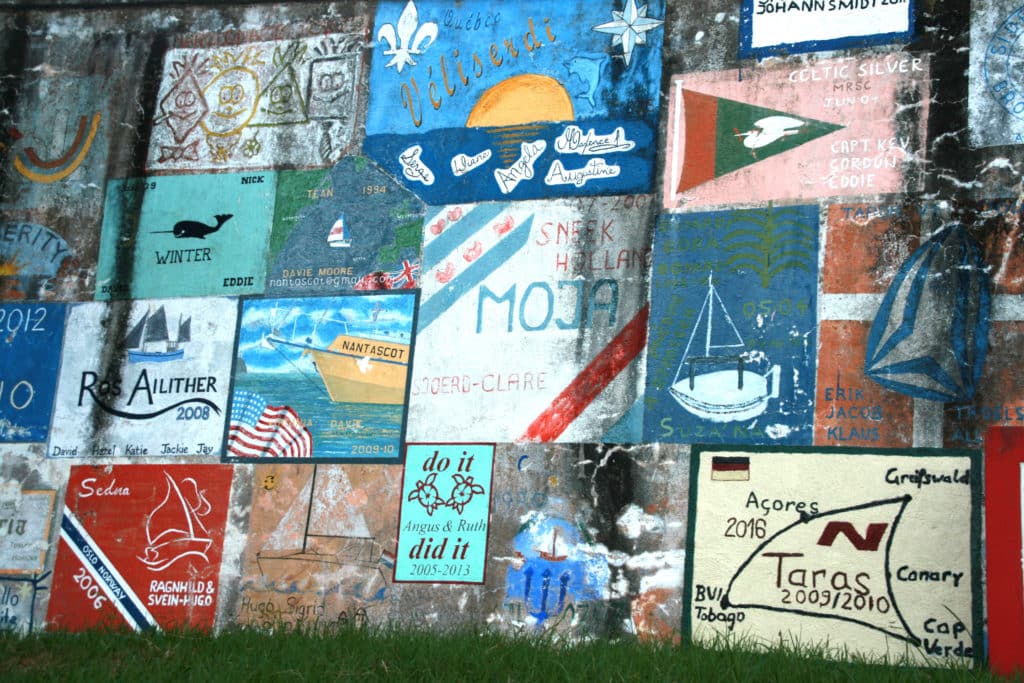
The most unusual part of our tour was a visit to the Landscape of the Pico Vineyard Culture, which has been designated as a UNESCO World Heritage Site. Centuries ago, the vineyard had been divided into small plots surrounded by black lava walls, the purpose of which was to protect the vines from the howling Atlantic winds. The view from the windmill in the center of it all was positively surreal.
Once back in São Roque, after dining at a local burger spot, we retired to Primo for what turned into a very long night with only snatches of sleep in the rolly mooring field. My loose plan had been to attempt to tackle an ascent of Pico — Ian was up for a try, though the gals seemed happy to continue sightseeing — but the day dawned rainy and foggy, and it was impossible to even see the mountain, let alone scale it. (Once again, thanks to our initial delay, we were a day late and a dollar short … the previous day would’ve been ideal for a big hike.) So we decided instead to return to Faial — which we’d only dashed through at the outset of the trip — and have a good look around. Heck, we’d yet to even down a famed gin and tonic at Peter’s Café Sport, one of the sailing world’s most celebrated watering holes.
Underway by 1100 with a reef in the main and 12 to 15 knots of northeast breeze, we sailed close-hauled out of São Roque, making good progress on the way to Horta, until the breeze faltered and we hoisted the full mainsail for a little more punch. Making only 3 or 4 knots, I was just about to call it a day, roll up the jib and start motorsailing when, just to again underscore how conditions can change rapidly in the Azores, the wind shifted 20 degrees and came banging in from the north. It turned out to be a cracking great sail in breeze that topped off in the low 20s, making for a fantastic power reach under full canvas that had Primo touching 8 and even 9 knots of boat speed. Roaring into Horta, it was a memorable way to wrap up the sailing portion of the journey.
Outside Horta, if there’s one thing everyone agrees you must take in on Faial, it’s the Capelinhos Volcano on the island’s western flank. It produced one of the seminal events in the history of the Azores: the creation of a deep crater by more than 300 explosions and earthquakes between September 1957 and October 1958. So we hailed one more taxi and set forth to check it out. It was a quiet, barren, haunted place, with loose sand and ash everywhere that gave the entire area an almost lunar feel. Today, there’s an Interpretation Center built among the remains that tells the tale of those fateful months, and there’s also a tribute commemorating President John F. Kennedy, who was instrumental in helping upwards of 15,000 people — nearly half the island’s population — to emigrate in the volcano’s aftermath, many to the United States. It was like finding the missing piece to a puzzle: Clearly, that still-remembered natural disaster is part of the reason I have so many friends from this small part of the world.
After that hot, dusty sojourn, the mandatory G&Ts at Peter’s Café Sport, with a big slice of lemon and rattling ice cubes, could not have been more refreshing. Burgees and stickers decorate the place, and the ones near our table — for the Water Brothers surf shop back in Newport, and the Fall River Police Department — made it feel like home. We wrapped up the festivities at a restaurant across the way called Canto da Doca, where hot lava stones are delivered to the table on which you cook your own thin slices of meat, fish and pork. “You are the chef,” said the waiter. Like every other meal we’d eaten on the trip, it was marvelous.
So, all in all, it was a good several days, enough to get a nice taste of these remote, alluring islands. Still, Pico remains unclimbed, Terceira unvisited, and I’ve yet to make my own landfall after crossing the Atlantic. Which means only one thing: We’re going to have to go back.
*Herb McCormick is CW’s executive editor. *

